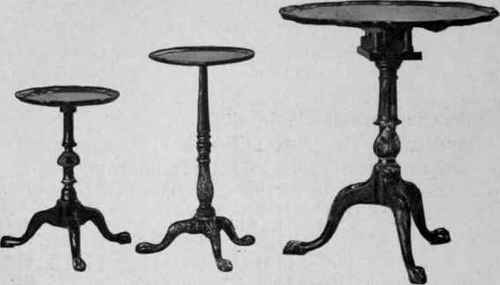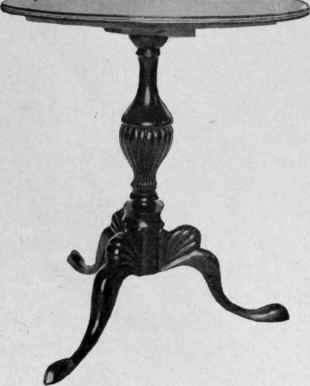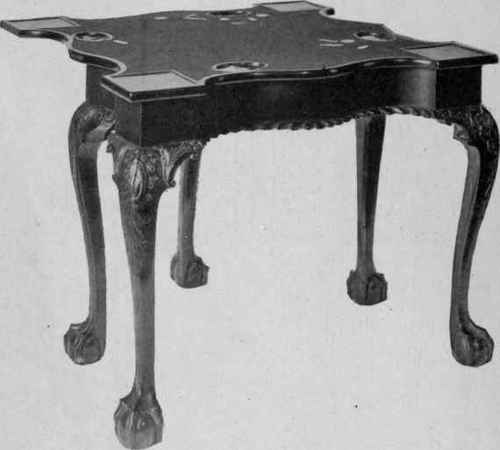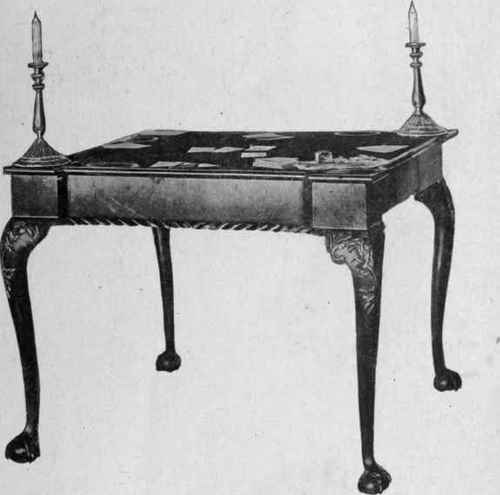Tables. Part 3
Description
This section is from the book "Furniture Of The Olden Time", by Frances Clary Morse. Also available from Amazon: Furniture of the Olden Time.
Tables. Part 3
Illustration 250 shows a Chinese fretwork table owned by Harry Harkness Flagler, Esq. Such tables were designed by Ince and Mayhew and Chippendale, and were called show tables, the pierced gallery serving to keep small curios on the table from falling off. Both of these tables were used as tea-tables, the raised rims protecting the tea-cups, more precious then than now.

Illus. 250. - Chinese Fret-work Table, 1760-1770.
Stands were made in different sizes, one being intended for a "light-stand" to hold the candlestick, and the smallest for a tea-kettle stand, to accompany the tea-table. Illustration 251 shows three sizes of stands, all smaller than those illustrated previously, and giving somewhat the effect of the three bears of the nursery tale. The middle stand, which has a dish-top, has a base which is exquisitely carved. The tiny kettle-stand is only eighteen and one-half inches high. These three stands also belong to Mr. Flagler.
Illustration 252 shows a small tea-table belonging to Mrs. C. M. Dyer of Worcester. A star is inlaid upon the top, the edge of which has a row of fine inlaying. The base has three fanlike carvings where the legs join the pillar.
The exquisite Chippendale card-table shown in Illustration 253 is not only beautiful in itself, but it frames what is a monument to the industry of the frail young girls who embroidered the top, and to the good housekeeping of its owners for one hundred and twenty odd years. The colors in this embroidery are as brilliant as when new, and never a moth has been suffered to even sniff at its stitches, which are the smallest I have ever seen. The work is done upon very fine linen, and each thread is covered with a stitch of embroidery, done with the slenderest possible strands of crewel, in designs of playing-cards, and of round and fish-shaped counters, in s mother-of-pearl shades, copied from the original pearl counters, which still lie in the little oval pools hollowed out for them in the mahogany frame. The fashionable game at that date was quadrille, which was played with these round and fish-shaped counters.

Illus. 251. - Stands, 1760-1770.
Dr. William Samuel Johnson, the first president of Columbia University, had four daughters, all of whom died in early youth, from comsumption. This embroidery was wrought by them, one taking the task as the other gave it up with her life. The same young girls embroidered the screen in Illustration 328. Small wonder they died young! Far better the golf and tennis which would occupy the daughters of a modern college president, if he were so fortunate as to have four.

Illus. 252. - Tea-table, about 1770.

Illus. 253. - Chippendale Card-table, about 1765.
The frame of this table is very beautiful, though it is cast in the shade by the extraordinary needlework. It is after the finest Chippendale design, and of the best workmanship. The wood is mahogany, and the table is owned by Mrs. Johnson-Hudson of Stratford, Connecticut.

Illus. 254. - Chippendale Card-table, about 1765.
A Chippendale card-table, owned by the writer, is shown in Illustration 254. The mahogany top is shaped in deep curves, with square corners and is an inch thick to allow the depth of the pools for counters. The lower edge of the table is gadrooned, and the two front legs are finely carved. The two back legs, which are stationary, are carved on the front side only, while the fifth leg, which swings under the leaf to hold it up, is plain, with simply the claw-and-ball foot.

Illus. 255. - Chippendale Card-table, about 1765.
Illustration 255 shows another Chippendale table with a baize-covered top. It has the pools for counters, and the corners of the top are shaped in square pieces to stand the candlesticks upon. The knees of the cabriole legs are finely carved, and the edge of the front is finished with gadrooning. It will be noticed that there is a leg at each corner with the table open; in closing, two legs turn in accordion fashion, and a leg is still at each corner of the closed table, with the top half the size. This card-table is owned by Harry Hark-ness Flagler, Esq., of Mill-brook, N. Y.

Illus. 256. - Pembroke Table, 1760-1770.
A style of table popular during the eighteenth century was called a Pembroke table, according to Sheraton, from the name of the lady who first ordered one, and who probably gave the idea to the workman. Illustration 256 shows a Pembroke table in the Chippendale style, with rather unusual stretchers between the legs. The characteristic which gives a table the name of Pembroke consists in the drop leaves, which are held up, when the table is open, by brackets which turn under the top. The shape of -the top varies, being square, round, oval, or with leaves shaped like the table in the illustration. They are always small, and were designed for breakfast tables. This table belongs to the Concord Antiquarian Society.

Illus. 257. - Pembroke Table, 1780-1790.
A beautiful Pembroke table owned by the Metropolitan Museum of Art is shown in Illustration 257. It is made of mahogany entirely veneered with curly sycamore, with a band of tulip wood around the top and leaves, which are exquisitely inlaid in a circular design, and upon the legs are lines of holly with an oval inlay at the top.
Continue to:


